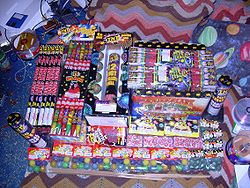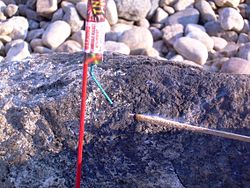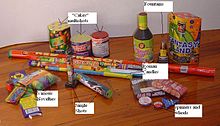- Consumer fireworks
-
Main article: Fireworks
Consumer fireworks are fireworks sold to the general public for use. They are generally weaker in explosive power compared to professional displays.
Contents
Examples of consumer fireworks
Consumer fireworks are often quite small and can be classified into two groups, daytime and nighttime.
Daytime fireworks
Daytime fireworks include most bottle rockets, smoke balls, firecrackers, and other fireworks that emit very little or no light. Some examples of daytime consumer fireworks include:
- Rockets — launch into the air, sometimes with a high-pitched whistling sound, with a report (explosion) at the end. Some varieties may emit sparks upon launch. Their sizes can range from an inch to about 6 inches long and 1/8 to 3/4 inches around, not including the stick. The smaller variety of these rockets are also commonly referred to as: "Bottle Rockets"; due to the commonality in which people use a bottle as a launching platform.
- Firecracker — an explosion occurs on the ground, often in a series. They range from 1 to 16,000+ on a single string.
- Smoke ball — emits colored smoke for a few seconds. Colors typically include white, green, blue, yellow, orange, fuscia, red and pink.
- Multiple Rocket Launcher — More commonly known as the: "Saturn Missile" typically launches a series of 16 to 300 rockets (dependant on the firework purchased) with a high-pitched scream each time, often with a report.
Nighttime fireworks
Nighttime fireworks include Roman candles, sparklers, jumping jacks, artillery shells, and other light-emitting fireworks. Some examples of nighttime consumer fireworks include:
- Repeater - a device in which one fuse lights and ignites a series of small mortars at once, these can contain up to 500 grams of gunpowder and offer a very exciting display.
- Roman Candles - A long tube that fires small balls of light in succession to one another. They can have as few as 5 shots, or as many as 200 shots.
- Sparklers — long-lasting, Magnesium rods that emits sparks, sometimes flickering.
- Artillery shells — A ball containing pyrotechnic stars that are launched from a launch tube. They often come in packs of 6 or 12 and shoot about 75 to 150 feet above the ground before exploding.
- Jumping Jacks — a small stick like a firecracker, only emitting jumping balls of light while spinning at high speed.
- Artificial Satellites - Small planes that spin quickly and fly into the air, often with an explosion.
- Skyrockets — Not to be confused with smaller rockets that can be used in the daytime, these are much larger, usually the size of artillery shells, attached to sticks and shoot about 100–200 feet in the air before exploding.
- Fountains — Usually in the shape of a cone or log that stands on the ground upright; when lit emits thousands of sparks of various colors which sometimes reports and can last from thirty seconds to three minutes.
- Flash;- usually small, grey, and cylinder shaped; it first shoots sparks up high in the air, then it creates a very bright flash (warning: do not look directly into the flash.)
- Air Bombs — shoot into the air around 35 feet in a green, red,etc. colored flair and explode with a very loud bang.
How consumer fireworks are used
The tools
Consumer fireworks can be used with a variety of tools. One set of tools has to do with basic ignition, such as lighters, matches, and punks. By using a rack, one can ignite a series of different fireworks to create a scene. These sometimes allow for the finales seen at professional fireworks displays to be created using consumer fireworks. Racks can be used with multiple types of fireworks, such as aerial shells, fountains, Roman candles, and the newest class of fireworks, 500 gram repeaters. Other tools are involved with the setup of fireworks for later display, such as shovels, various hand tools, and spare visco fuses. The true scope of tools used with consumer fireworks is limited only by the displayer's imagination.
Lighting and launching consumer fireworks
There are several ways by which fireworks can be ignited. The most basic of these is simply flame from a match, lighter or other device that emits flames. Another way to light fireworks is using a device called a punk. A punk is a long, thin piece of wood covered in a substance that burns very slowly, producing only heat, with no flame. The most complicated method used to ignite consumer fireworks is to use electronic ignition. This is the preferred method of many professional pyrotechnicians worldwide because of the vast improvement in operator safety. Unfortunately, there are few electronic ignition (often called "e-fire") systems that use readily available materials.
Consumer Fireworks Regulations
Laws regarding consumer fireworks between countries and states.
United States
In the United States, the laws governing consumer fireworks vary widely from state to state, or from county to county. It is common for consumers to cross state and county lines in order to purchase types of fireworks which are outlawed in their home-jurisdictions. Fireworks laws in urban areas typically limit sales or use by dates or seasons. Municipalities may have stricter laws than their counties or states do.
The Consumer Product Safety Commission defines what fireworks may be considered consumer fireworks. Consumer fireworks in the United States are limited to 500 grams (this was previously 200 grams until recent years) of composition, and firecrackers may have up to 50 milligrams of flash powder. Reloadable shells are limited to 1.75" in diameter, and shells in pre-fused tubes are limited to 2". Any fireworks that exceed these limits are not considered consumer fireworks and need an ATF license.
The American Pyrotechnics Association maintains a directory of state laws pertaining to fireworks.
Four states (Delaware, Massachusetts, New Jersey, and New York) ban the sale and use of all consumer fireworks, including novelties and sparklers.(The New York Legislature had passed a Safe & Sane Fireworks bill. However, it was vetoed by Governor Andrew M. Cuomo )
Four states (Illinois, Iowa, Maine, and Vermont) permit residents to purchase and use only wire or wood stick sparklers and other novelties. (Maine has passed a new fireworks law to take effect in 2012)
Nineteen states (California, Colorado, Connecticut, Florida, Georgia, Kentucky, Idaho, Maryland, Michigan, Minnesota, North Carolina, Oregon, Pennsylvania, Rhode Island, Utah, Virginia, Wisconsin, West Virginia, the District of Columbia, and Arizona) allow residents to purchase and use non-aerial and non-explosive fireworks (also called "safe and sane") like novelties, fountains and sparklers.
Michigan Legislators have passed and enrolled a bill that is currently pending the signature of Governor Rick Snyder allowing the sale and use of all consumer fireworks, however, sellers must pay a fee ($600-1000) to sell higher-power consumer fireworks, and a tax will be added to fireworks purchases.[1]
For example: California has very specific requirements for the types of consumer fireworks that can be sold to and used by residents. Even then each city can and often does place restrictions on sale and use.
Another example: In Minnesota only consumer fireworks that do not explode or fly through the air are now permitted to be sold to and used by residents.
Twenty-Two states — Alabama, Alaska, Arkansas, Indiana, Kansas, Louisiana, Mississippi, Missouri, Montana, Nebraska, New Hampshire, New Mexico, North Dakota, Ohio, Oklahoma, South Carolina, South Dakota, Tennessee, Texas, Washington and Wyoming — permit the sale of all or most types of consumer fireworks to residents. Many of these states have selling seasons around the 4th of July and/or Christmas and New Year's Eve. Some of these states also allow local laws or regulations to further restrict the types permitted or the selling seasons.
For example: Missouri permits all types of consumer fireworks to be sold to residents with two selling seasons; June 20–July 10 and December 20–January 2. South Carolina permits all types of consumer fireworks except small rockets less than ½” in diameter and 3” long to be sold and used by residents year round.
Two states (Hawaii and Nevada) allow each county to establish its own regulations.
For example, Clark County, Nevada, where Las Vegas is located, allows residents to purchase and use only non-explosive and non-aerial consumer fireworks during the 4th of July, while other counties permit all types of consumer fireworks.
Many states have stores with all types of consumer fireworks that sell to non-residents with the provision they are to remove the purchased fireworks from that state. This is why there are so many stores selling fireworks in states like Pennsylvania, Ohio, Florida, Missouri, New Hampshire, Nevada and Wisconsin with all types of consumer fireworks, even though residents are limited or prohibited from buying or using those very same consumer fireworks unless they have the appropriate licenses and/or permits.
Many Native American Tribes have consumer fireworks stores on reservation lands that are exempt from state and local authority and will sell to people that are not in the tribe.
United Kingdom
Main article: British firework classificationIn the United Kingdom fireworks cannot be sold to people under the age of 18 and are not permitted to be set off between 11pm and 7am with exceptions only for New Year, Bonfire Night (5 November), the Chinese New Year and Diwali.[2]
Europe
In Bergen, Norway, fireworks can only be purchased by people 18 or older. Class 1.3G professional display fireworks are for sale, and only be fired between 18:00h and 02:00h on the celebration day.[citation needed]
In Finland, fireworks (other than novelties and sparklers) are sold only between Christmas and New Year, and their use is allowed only on New Year's Eve from 6pm to 6am the following morning.
In Germany, fireworks are available for purchase from most stores in the days prior to New Year's Eve, allowing families to have their own celebrations in their backyard.
In the Netherlands, fireworks cannot be sold to anyone under the age of 16 and are only sold the last three days up till and including Dec 31, unless one of those days is a Sunday, then the sale period is extended to 4 days.
In Iceland fireworks may only be used on the days around new year.
Oceania
In Australia, Type 1 fireworks are permitted to be sold to the public. For anything that has a large explosion or gets airborne, users need to register for a Type 2 Licence. The Australian Capital Territory allows fireworks to be sold to residents 18 years or older during the week leading up to the Queen's Birthday long weekend for personal purposes. A similar allowance is made in the Northern Territory in the days leading up to Northern Territory Day (July 1). The types of fireworks allowed for sale is restricted to quieter fireworks, which can only be used during the long weekend and only at the address provided to the seller.[citation needed]
In New Zealand fireworks cannot be sold to anyone under the age of 18 (previously 14), and may only be sold for the four days leading up to and including November 5. However, fireworks are able to be used at any time of the year (i.e.: there is no time restriction on when fireworks can be used, even though there is a restriction on the sales time of fireworks). The types of fireworks available to the public are multi-shot "cakes", Roman candles, single shot shooters, ground and wall spinners, fountains, cones, sparklers, and various novelties, such as smoke bombs and pharaoh's serpents. sales of fireworks have become increasingly restricted in recent years. Skyrockets, and other fireworks where the firework itself flies, were banned in 1994. Firecrackers and Bangers were banned in 1993. As of 2007, sparklers may only be purchased no more than 50 at a time in packs with other fireworks. This is due to the popularity of sparkler bombs.
References
- ^ "Michigan HB 4293'11". Michigan House of Representatives. http://legislature.mi.gov/doc.aspx?2011-HB-4293. Retrieved 13 November 2011.
- ^ Statutory Instrument 2004 No. 1836 The Fireworks Regulations 2004, United Kingdom.
- ^ Guy Fawkes 2007 FAQ, New Zealand
Categories:
Wikimedia Foundation. 2010.





